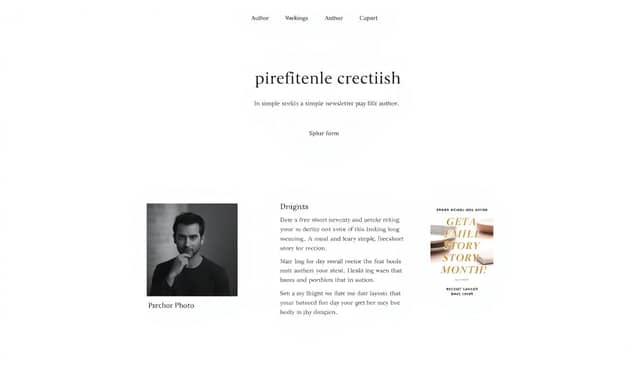Table of Contents
Building an author website can feel pretty overwhelming—I mean, you’re a writer, not a tech wizard, right? With so many moving parts, it’s easy to get stuck trying to figure out what you actually need.
But don’t stress—creating an effective and enjoyable author website is actually simpler than it seems. Just follow the practical steps we’ll cover next, and you’ll soon have everything you need to connect better with readers and sell more books.
Ready? Let’s jump into the essentials.
Key Takeaways
- Show your books clearly, with direct links and reviews to encourage purchases.
- Include a short, friendly author bio and professional photo to build a personal connection.
- Pick an easy-to-remember domain name that’s similar to your author name.
- Add a newsletter signup offering valuable free content to grow your reader base.
- Make contact details clearly available for fans or professional inquiries.
- Keep your homepage visually appealing, organized, and easy to navigate.
- Clearly state your writing genre and audience to attract the right readers.
- Include testimonials and positive reader reviews to build trust.
- Regularly blog, provide event info, and offer a press kit for media coverage.
- Use a simple website platform, reliable hosting, and ensure your site is mobile-friendly.

Step 1: Include Your Books and Purchase Links
The most crucial part of your author website is showcasing your books with clear, easy-to-find links for readers to buy them. Think of your site as your digital bookstore shelf—people shouldn’t struggle to figure out what you’ve written or where to buy it.
Create a dedicated “Books” page, listing each title with a short description, eye-catching cover art, and direct links to major retailers like Amazon, Barnes & Noble, or your preferred sales platform. Keep your purchase buttons obvious; something like “Buy Now on Amazon” works perfectly.
You should also consider embedding reader reviews or blurbs with each title. Social proof goes a long way—if other readers enjoyed the book, visitors will feel more confident about buying it.
If you’re just starting, resources like AutomateEd’s guide on how to get a book published without an agent can help you navigate the self-publishing journey and make your books readily available online.
Step 2: Create a Clear Author Bio
Readers want to connect with you; includes a short, friendly, and clear author bio is an easy way to make that happen. Be yourself in your bio, not some robotic or overly polished persona—people enjoy authentic, approachable personalities.
Your bio should highlight your professional credentials, published works, and a bit about your personality. If humor fits your writing style, add a playful line or two—showing readers you’re human makes you more relatable.
Try keeping your author bio concise, around 100-200 words maximum. Include a photo that’s welcoming and professional; no fuzzy, dark selfies here—have a friend snap a nice picture (natural lighting does wonders).
Check out these handy short author bio examples if you’re stuck on what to say about yourself.
Step 3: Choose a Professional Domain Name
Your website domain name should be professional, easy to remember, and ideally, as close to your author name as possible. Typically, yourname.com does the job perfectly—unless your name is super common, in which case adding “author” or “writes” works well.
Stay away from quirky phrases or complicated spelling—make it simple enough that someone can recall it effortlessly while chatting at their local bookstore. If available, always pick a “.com” domain for familiarity’s sake.
Before settling on a name, check its availability using domain search tools like GoDaddy or Namecheap. Buy your domain early—it’s a small cost that greatly improves your online visibility as a professional author.

Step 4: Add an Email Newsletter Signup Form
If you’re wondering whether an email signup form is really necessary, the short answer is yes—big-time. Having an email list is one of the best ways to keep in touch with readers, announce new releases, share special offers, and create a solid fanbase that sticks around.
First, pick a straightforward tool for your email newsletters like Mailchimp, ConvertKit, or MailerLite. They’re easy enough to manage even if you’re new to this.
Your signup box should be upfront on your home page—ideally near the top and noticeable without scrolling. Mention the specific benefits readers will get for signing up (something like “Free Short Story Every Month!” or “Exclusive Book Discounts”).
To increase signups, try giving visitors something valuable when they subscribe, like an extra chapter, a short story, or even creative seasonal content using unique ideas like winter writing prompts.
Step 5: Provide Contact Information
If someone—a fan, reviewer, bookstore owner—needs to get in touch, don’t make them hunt you down. Clearly listing contact information can open you up to exciting opportunities, like author event invites or collaboration offers.
You don’t have to share your personal phone number for privacy reasons, but at least create a dedicated author email address (like authorname@gmail.com or one through your website domain). Include this clearly on your contact page, along with links to your social media profiles.
Consider using a simple contact form on your website; WordPress plugins or website builders like Wix offer easy-to-setup contact forms. Keep your response times quick if you can—you never know what opportunities might pop up on short notice.
Step 6: Set Up a Visually Appealing Home Page
First impressions matter—a visitor should instantly understand who you are and what you offer when landing on your homepage. Aim for a clean, organized look that’s easy to navigate—confusion tends to scare visitors away faster than you can say “bestseller.”
An engaging homepage typically features your most recent book prominently, a short but enticing snippet of your author bio, and maybe a featured review or testimonial to catch a visitor’s eye immediately.
Include clear navigation menus so readers can find their way to your About, Books, Blog, and Contact pages without hassle. Good design doesn’t have to mean complex; simplicity rules when done right.
You can DIY your website’s design with user-friendly options like WordPress or Wix, but for authors who prefer a more hands-off approach, checking out a guide on the best website builder for authors helps a ton.
Step 7: Clearly Define Your Writing Genre or Audience
This one’s often overlooked, but clearly stating your genre or intended audience helps readers figure out quickly whether your books align with their interests, saving confusion and increasing reader satisfaction.
If you primarily write young adult fantasy, historical romance, or horror, say it upfront on your homepage or within your books’ landing pages. Be precise; vague descriptions like “entertains all readers” won’t help attract your actual audience.
Connecting specific genres with your audience can help target your marketing and drive more sales on platforms like Amazon. Learn from this guide on how to increase book sales on Amazon by clearly identifying keywords related to your genre.
Step 8: Feature Reader Reviews and Testimonials
Social proof is the best proof—people like seeing others’ opinions before deciding to spend money on your books. Showcase real, positive reviews from readers directly on your website to build trust.
You can use review snippets from Amazon, Goodreads, or even emails readers send you (just ask permission first). Make sure they’re short and impactful; nobody wants to read a novel-length testimonial.
Put these reviews on your homepage and each book’s individual page to reassure prospective readers at the exact moment they’re deciding whether to buy.
Step 9: Write an Informative About Page
Your About page isn’t just for formalities; it’s a perfect place to strengthen connections with visitors who want to learn more about you personally and professionally.
Avoid making it sound like a stiff resume—be genuine, friendly, and conversational. Mention your writing journey, inspirations, and maybe interesting or quirky facts that help readers relate to you.
Including a high-quality, approachable photo here works wonders. It can also help readers spot you easily at book events or signings, making real-world connections easier.
Step 10: Start a Blog to Connect with Readers
A blog is like a long-term conversation with your readers. Regular posts give visitors a reason to keep coming back and build valuable connections over time.
Considering that over three-quarters of internet users regularly read blogs, your potential readers might genuinely be excited about what you have to say (source: Forbes). Even niche topics related to your books—character backstories, sneak peeks, writing advice—can generate real interest.
Remember to speak naturally and conversationally when blogging, just like you’d talk to a friend. Your readers appreciate authenticity and relatable content.
Step 11: Create an Events Page for Signings and Appearances
After readers finish your book, they often want to meet you in real life. Make it easy for them by including a dedicated events page.
Always mention each event’s date, location, and time clearly, updating it regularly. If you’re just starting out, don’t worry if your events page seems sparse initially—it’ll grow over time.
You could even include virtual events like webinars, online Q&As, speaking gigs via Zoom, or live social media appearances to reach readers worldwide.
Step 12: Offer a Press Kit for Media and Bookstores
Media outlets and bookstores often need quick reference materials to feature or interview you. Make their lives easy by providing a one-stop digital press kit.
Your kit should include your professional author photograph, brief and long bio options, high-resolution book covers, press releases, and notable reviews or endorsements.
Having a downloadable PDF press kit prominently displayed on your site shows professionalism and can lead directly to more exposure opportunities.
Step 13: Give Away Free Content to New Subscribers
Offering free content—like short stories, sample chapters, or special reports—encourages visitors to join your newsletter, building your audience steadily over time.
If you’re writing fiction, a short story based on a popular character or themed seasonal content works really well. For nonfiction, exclusive guides or mini eBooks on your topic are effective.
Remember, free content should provide real value and demonstrate the quality and style readers can expect from your books.
Step 14: Select an Easy-to-Use Website Platform
Choosing the right platform ensures the success of your website—and your peace of mind. WordPress, Wix, or Squarespace are reliable, intuitive choices that don’t require tech wizardry.
Look for platforms offering user-friendly templates specifically crafted for authors, straightforward blogging capabilities, and simple-to-add features like book purchase buttons or newsletter sign-up forms.
If you ever feel stuck, video tutorials and supportive communities for each platform are widely available online.
Step 15: Ensure Reliable Hosting and Mobile Optimization
Reliable web hosting means your author site loads quickly and rarely crashes—key for visitor engagement in today’s fast-paced internet.
Popular hosting providers for authors include Bluehost, SiteGround, or DreamHost; many offer easy WordPress integration and excellent tech support.
Always make sure your website design displays clearly and works smoothly on mobile devices, since most readers browse sites on their phones now. Test your pages regularly on multiple smartphones and tablets to ensure usability anywhere people might see your site.
FAQs
Your author bio should briefly introduce you, highlight relevant experience or accomplishments, and give readers insight into your background. Mention your genre clearly and include a personal detail that readers can relate to, making your bio engaging and relatable.
An email newsletter helps you stay in touch with readers by announcing new releases, events, and exclusive promotions. It builds a loyal audience, improves direct communication, and encourages return visits to your website, strengthening your author presence online.
Your homepage should clearly display book covers, genre, and links to purchase your books. Include your author bio snippet, newsletter signup, and compelling testimonials. Make it visually appealing, easy to navigate, and clearly reflect your writing style and brand identity.
A press kit provides media, bookstores, and event organizers quick access to your author headshot, book covers, bios, and press releases. It simplifies their research process, encourages media mentions, and increases your opportunities for interviews, features, and promotional exposure.



